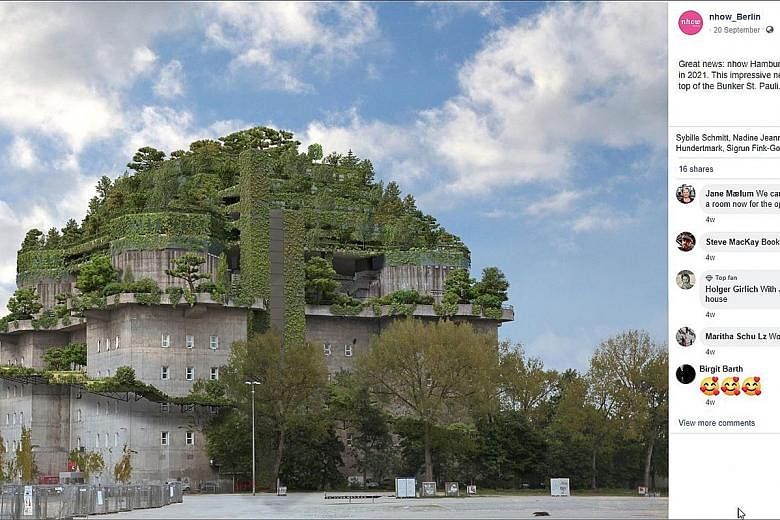BERLIN •A former Nazi bunker in Hamburg, Germany, built by forced labourers to shelter tens of thousands of Germans during Allied air raids in World War II, will soon house hotel guests.
The 136-room nhow Hamburg, which is being designed by the NH Hotel Group, will open in mid-2021 on top of the Bunker St Pauli, one of thousands of air raid shelters built across the country by the Third Reich. The hotel will be part of a five-storey tiered garden atop the bunker.
Developers and project managers for the hotel could not be reached for comment, but Ms Juliane Voss, a spokesman for the Spanish hotel chain, said they were "aware of the history of the building" and wanted to show "responsibility" for it.
"We understand it's a sensitive topic," she said, adding that there were plans for a memorial on the site. "We would like to send a positive signal to the city of Hamburg."
She added that the establishment was not a luxury hotel, but "a design and lifestyle hotel in the upscale segment with an open approach to the local community".
By the end of the war, more than 1,000 bunkers had been built in Hamburg alone, more than any other German city, according to the city's tourism website. Today, about 650 still stand.
The St Pauli structure is one of the largest. Designed to hold 18,000 people, it has extra-wide entrances so mothers could push children through in strollers.
The imposing castle-like structure, 75m wide and 35m high, is also called Hochbunker, which translates to "high bunker". During heavy bombing in the summer of 1943, at least 25,000 Germans sought shelter there.
After the war, discussions to destroy the structure ended when it became clear that the amount of dynamite needed to bring its thick walls down would blow the residential area around it to smithereens.
The space was used as a television broadcasting hub in the 1950s and, more recently, as a work space for musicians and artists and a venue for hosting live concerts and nightclubs.
It is not the first Nazi-era site to catch the eye of a private developer in Germany. Other sites included the former Gestapo headquarters in Hamburg and a never-completed holiday resort that Nazi leader Adolf Hitler had intended to be used for workers through his Strength Through Joy project.
The challenge when integrating these sites into modern-day landscapes is "how to reconcile commemoration and consumption or consumerism", said Dr Thomas L. Doughton, a senior lecturer at the College of the Holy Cross in Massachusetts who takes students on tours of Holocaust sites across Europe to explore the politics of memory.
"Dark tourism", as the growing trade is known, involves profiting from places that were once sites of shame and horror, contributing to what Dr Doughton calls the "gentrification of terror".
"Part of the concern with some people in Hamburg, as well as in other locations in Europe and elsewhere," he said, "is that the real significance of some of these sites will become lost."
Mr Tobias Helbing is part of a volunteer group in Hamburg that is organising the rooftop garden, known as the Hilldegarden, for which 4,700 shrubs, plants and trees are growing in wait to be hoisted atop the bunker.
"It's time to move on," he said, "but very respectfully."
In addition to the garden, which will be open to the public, the group is creating a 52 sq m exhibition space to commemorate the structure's past. They are collecting artefacts and interviewing locals who were protected by the bunker, as well as tracking down the people who were forced to built it, about whom little is known.
"We don't want to hide the history," he said. "We want to make it more visible and more transparent."
NYTIMES

